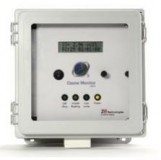
where l is the path length (0.1 cm) and . is the absorption cross section for
ozone at 254 nm (1.15 x 10-17 cm2 molecule-1 or 308 atm-1 cm-1), which is
known with an accuracy of approximately 1%. The 2B Technologies instrument
uses the same absorption cross section (extinction coefficient) as used in other
commercial instruments.
When there is no ozone in the cell, a difference in light intensity at the reference
and sample photodiodes can be expected, and it will cause a zero offset in the
readings. This light intensity difference is inherent in the instrument due to the
different properties of the two photodiodes, drift in the angle of the beamsplitter,
contamination in the cell and thermal drift in any of the optical components.
The zero drift has been determined to be less than or equal to 2% of full scale
per month, non-cumulative and can easily be corrected for by using the zero
function described below. The zero drift does not affect the slope calibration
factor in any way, and the instrument does not need to be recalibrated after
performing the zeroing function.
The pressure and temperature within the absorption cell are measured so that
the ozone concentration can be expressed as a mixing ratio in percent by
volume (vol%). The fraction of the sample that is ozone can then be calculated
and used to determine the ozone concentration in percent by weight in either
air (Wt.% air) or oxygen (Wt.% O2). The instrument displays and records the
cell temperature and pressure in addition to the ozone concentration. The cell
pressure is displayed and logged in units of mbar, torr or psia and the cell
temperature in units of either oC or K.
In principle, the measurement of ozone by UV absorption requires only a zero
calibration to account for the different light intensities at the reference and
sample photodiodes. However, non-linearity of the photodiode response and
electronics can result in a small measurement error. Therefore, each
instrument is compared with a reference ozone monitor calibrated to the
International Ozone Association (IOA) buffered KI method. These results are
used to calibrate the Ozone Monitor with respect to a slope (gain). The
correction for slope is recorded in the instrument Birth Certificate. The slope
parameter is entered into the microprocessor prior to shipment. The user may
change the slope parameter from the front panel if desired. It is recommended
that the instrument be recalibrated at least once every year and preferably
more frequently. The zero may drift due to temperature change or chemical
contamination of the absorption cell. As discussed below, an accurate zero
correction can be measured from time to time using zero gas.